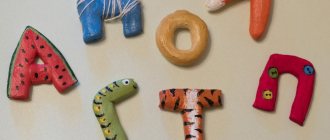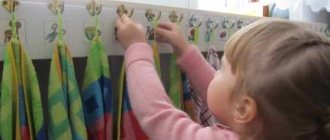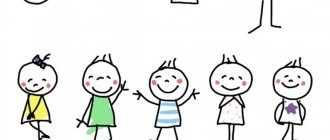Article:
Letters surround us everywhere.
The child sees them in books and magazines, on food packages, and in store windows. He can't help but wonder what it is. Over time, he begins to understand that adults can read, begins to copy his parents, learning a poem or fairy tale by heart, and pretending that he is reading a book. Experts recommend teaching a child to read shortly before school, since at an earlier age his brain is not yet ready to perceive such information. You can learn sounds with it, learn to distinguish them in spoken speech, and begin to master the alphabet. This preliterary period is very important, since thanks to it the child will be able to learn to read fluently and understand what he reads.
Content:
- Learning letters: where to start? Is your child ready to learn the alphabet?
- Advice from psychologists
- 3-4 years
- Game techniques
- A brief overview of modern primers
Pros and cons of homeschooling
Some of the positive aspects of teaching reading at home include:
- Floating schedule. Mother and child do not need to rush, adapt to the schedule of the teacher or courses.
- Ability to use different techniques. Typically, teachers and training centers specialize in a narrow area. For example, they work with children only with Zaitsev’s cubes, or according to Zhukova’s method. At home, through trial and error, you can choose the most effective technique specifically for your tomboy. But this takes time.
- Individual approach. At home they do not study in groups, but one-on-one. You can devote exactly as much time to a topic as a single student needs, without waiting for those who are lagging behind and without rushing after those who are running ahead.
- Contact with parents is maintained. A preschooler is emotionally comfortable being with his parents in difficult moments, and learning to read is a responsible undertaking.
There are not many negative aspects, but they do exist. Among the disadvantages of learning to read at home are:
- Lack of training of parents Unfortunately, mothers and fathers who do not have special education make a lot of mistakes when learning to read. For example, they name letters with overtones, make pauses between phonemes in the process of adding syllables and words. Children get used to reading incorrectly, and it is very difficult to retrain them.
- The child is not socialized. In pedagogical centers, the child communicates with other adults, gets used to the school environment, responsibility, and learns behavior. He won't get that experience at home.
Where and how to teach a child to read is up to parents to choose. If you have a difficult financial situation, then the only option left is at home. In this case, spend time studying books and methods of working with preschool children. This will help teach a kindergartener how to read and instill a love of literature.
Learning letters: where to start?
Photo source – www.freepik.com
Before teaching your child letters, you need to decide: 1) whether he is ready to learn, and 2) what goal you are pursuing. If the reason lies in the parents’ desire for the child to know as much as possible in order to show off to others, it is better to leave this idea. The young student himself must show an interest in knowledge and want to learn the alphabet. You need to concentrate on his desires and abilities.
If parents see that their child is inquisitive and shows interest in new knowledge, this is a signal that they can start learning letters. It is important to remember that any theory must be supported by practice. Having learned the letters, proceed to syllables, and then gradually move on to reading.
The main task of parents is to be patient and convey information in an accessible form, and also not to force the child to study if he does not want to. It is better to conduct classes in the form of a game.
You need to start training only if the child himself wants it, or if he will soon go to school. According to the requirements of educational institutions, when entering school, children must know the basics - letters, numbers. Without these basic skills, studying will be much more difficult.
Is your child ready to learn the alphabet?
To determine how ready the baby is, there are psychological tests. Parents are asked to answer yes or no to the following questions:
Development of cognition
- Does the child understand such judgments - right/left, much/little, big/small, low/high, near/far, under/above.
- Can understand simple situations in which it is necessary to divide objects according to classification. For example, identify a group of green and red objects.
- Is he able to think of the end of a fairy tale or story?
- Does he consistently fulfill three requests, without reminding his parents?
Basic knowledge
- Has the child ever been to a post office, a store, or a zoo? How broad his horizons are.
- Have you visited the library?
- Did his parents read fairy tales to him, starting from a very early age?
Speech development
- Is it easy for the child to name the objects that surround him?
- Is it easy to answer the questions asked?
- Is he able to tell the purpose of household things - a vacuum cleaner, an iron, a refrigerator.
- Can he determine the location of objects - on, under, inside, near.
- How clearly does he pronounce words?
- Can he conduct a dialogue?
Development of the emotional sphere
- Is the child having fun with friends and communicating with family?
- Can he adapt to new changes in his daily routine?
- Knows how to compete and cooperate with friends.
Communication level
- Can he share toys and communicate with other children?
- Knows how to listen to others and not interrupt.
Level of physical development
- Is the child diligent, is he able or not to sit quietly for a certain period of time?
- Plays with the ball, jumps, goes down and up the stairs.
- Gets enough sleep, has a good appetite, and knows how to extinguish emotional outbursts.
Development of visual abilities
- Can a child distinguish between similar and dissimilar and classify them into separate groups?
- Distinguishes short words and syllables with similar sounds - forest/weight, cat/year.
- Able to notice changes - if three pictures were shown at first, and then one was removed.
- He knows how to spell his name, what at least three letters from the alphabet look like.
- According to the instructions of an adult, he is able to lay out pictures on the table.
- Knows the order of reading words - from left to right.
- Folds the minimum number of puzzles - from 10.
Hearing development
- Rhymes words.
- Repeats words and numbers after adults.
- Understands that words that are similar in pronunciation have different sounds.
- Retells what he heard.
Interest in reading
- Enjoys looking at the pictures.
- Loves to listen to fairy tales.
- Interested in letters.
Thinking about learning the alphabet in preparation for school? Find out how many words per minute a preschooler and primary school child should read and for what “grade”.
If parents can answer affirmatively to at least 50% of the questions proposed, they can safely offer their child to study the alphabet.
Advice from psychologists
To learn the alphabet with your child, speech therapists and psychologists recommend following these tips:
- do not teach letters strictly in alphabetical order;
- do not learn all the letters mixed together;
- first learn vowels, then consonants;
- name the sound, not the spelling of the letter (incorrect - BE, DE, correct - B, D);
- consolidate what has been learned with practice - show how to write, give the child the opportunity to write with chalk, paints, or with his finger on the cereal.
Should a first grader be able to read?
This question is a stumbling block for many parents. There are two camps - those who teach their child to read very early, and those who rely on the work of the teacher in the first grade - they say, they will teach you everything at school. Any of these options carries risks:
✓ children who already read fluently by first grade will simply get bored in class. They will not be interested in following classmates who are only learning the alphabet and trying to read syllables;
✓ children who do not yet know how to read by school will still learn - just when? The standard school curriculum provides for testing reading techniques at the end of the first half of the year - before the winter holidays. The reading rate is 25-30 words per minute. What if the child does not pass the test because he has not been able to make friends with the book over these few months? Of course, nothing terrible will happen, but disappointment and demotivation for a first grader who cannot read are guaranteed.
The optimal middle option is to start actively learning to read a year before school. The child will have enough time to learn letters, syllables, and learn to connect them into words. And all this at a calm pace, without competition and evaluation from the outside. And already at school, even if the reading skill has not yet been fully mastered, the laid foundation will serve as a springboard for quick and effective learning.
Methods for studying vowels/consonants
To teach your baby letters, you need to be patient. You should not demand too much, otherwise he will lose interest in knowledge.
First, talk about each vowel letter separately. For example, the letter A. Name it, show how it looks in writing, how to write it. Next, name the words in which it is present. Show pictures that depict objects, people and animals whose names contain the letter A. Next, invite the child to independently remember words that also contain this letter. You can consolidate the theory with practice - while walking, pay attention to store signs, together with your child, try to find a letter that is already familiar to him.
After the previous sound has been learned, you can proceed to the next one. To captivate the baby, it is recommended to purchase cards with letters, a board, cubes, bright pictures and books.
⠀
When vowels have been studied and reinforced in practice, you can begin to master consonants. First, introduce the child to the sound, then show him the letters. Learn the sound D, not the letter DE .
Otherwise, he will experience disorientation in the process of combining syllables into words. The method of studying consonants does not differ from the method of vowels. It is important to practice as often as possible, to remember together words that contain the learned letter. Sequence of actions, repetition of learned material, patience - this is what will help parents.
Games
Game-based learning is considered the most effective. Do not waste time on educational entertainment for preschoolers, forget about boring lessons, then you will achieve success faster.
Letter learning games
- We draw letters, paint them, sculpt them. Use coloring books, prepare stencils yourself.
- Puzzles. Assembling letters from parts. Make the puzzles yourself and cut them into large pieces or buy teaching material at the store.
- Memory. Write down the letters on small pieces of paper. Lay out the cards on the table. Let the baby remember, then turn it over. Let him look for the desired letter according to the model.
- We write on sand and semolina. Attaching letters on loose material trains memory and motor skills at the same time.
Games for the ability to add syllables
- Collect the word. Syllables are laid out on cards in front of the preschooler. Task: collect words, one or more.
- Guess a riddle. In front of the baby there is a path of words, among them you need to find the hidden word.
- Word in word. The child is offered a long word, 12-15 letters. You need to make smaller words from it.
- Walking games. Prepare the playing field yourself. Write the letters in the empty cells. When walking the chip, the child reads the sounds, putting them into syllables.
To develop reading skills
- Sounds in a circle. Children need to come up with words that begin with the last letter of the previous word. For example, window-OSA-Album, etc.
- Reading with adults. The book is placed on the table so that the text is visible to the parent and baby. When one reads, the other follows. Stop unexpectedly and ask to continue. Attention and visual memory develop.
- We are looking for an error. Parents give the child a text with errors and catches. For example, KoSa ate all the grass in the field. Sol(b) was spilled onto the table. The child’s task is to find and correct the mistake while reading.
- Who's speaking? Animal toys and clean leaves will come in handy. Together with your child, sign the cards: Mee, Oink, Mu, etc. Empty will substitute the required syllable for the toys and read.
How to learn the alphabet - adapt to the child’s age
3-4 years
To quickly teach a 3-4 year old child, you need to start with simple letters (those that are most often used in speech). After this, gradually move on to complex and rarer ones. This way he will remember the words better and faster.
You only need to learn one letter per lesson. You shouldn’t conduct “lessons” every day - it’s better to do it at intervals of two to three days.
Secure the result using cards, cut out letters from paper or fabric, sculpt from plasticine or dough. Each time before a new sound, repeat the material covered. At 3 years old, a child will be interested in listening to and learning a funny song or rhyme with the alphabet.
At this age, there is no need to force or rush the child. School is not soon yet, quick preparation for it is not required. Conduct classes only at the request of the baby.
It is important to consider the following points when teaching three-year-olds:
- do not expect your child to learn the alphabet quickly (be patient and devote time to studying regularly);
- do not exercise for more than 7 minutes a day;
- learn letters in pairs - A-Z, U-Y;
- do not proceed to study consonants without vowels;
- Remember that at this age imaginative thinking plays a big role, so you need to purchase bright books, toys and pictures.
It’s easier to conduct classes with a four-year-old. At this age, children have more developed processes of perception and analysis of abstract information. You can add puzzles, magnetic letters, cubes to the pictures, attract fairy tales, rhymes, stickers, posters. For better memorization, name the letters and write them immediately, encourage the child to draw them with a pen, pencil, or chalk.
Try an interesting and quite effective technique: forming letters from simple improvised means - buttons, sticks, sand.
You can learn the alphabet with a four-year-old child through the following games:
- cut out letters from paper, and then choose at random and name them;
- show pictures of animals, things, etc., and ask what letter the depicted object begins with;
- learn rhymes and songs with the studied sounds.
5-6 years
5-6 years is the most optimal age for teaching a child the alphabet, and as a result, reading. He must speak and pronounce sounds correctly. If you have difficulties with this, you should visit a speech therapist. At this age, activities cease to be purely playful in nature. The child needs to be told why he needs to know the alphabet. For example, say that now he will be able to read books on his own.
Advice to parents. Five-year-olds can be offered special educational books and notebooks. For example, you should take a closer look at game books with puzzles, mazes, crosswords and other interesting tasks.
⠀
Parents of preschoolers can purchase copybooks in which children will perform various educational tasks. A good option is “First words. Recipes for preschoolers. With tasks. 5-6 years” – publication authored by S.V. Petrenko. This manual is not overloaded with exercises; the words are given in enlarged form. Plus, after completing the task, the child is asked to independently evaluate his work (circle the sun with the appropriate rating) - this will allow the child to feel what it is like to be a schoolchild.
For training, you can use the methods of 4-year-olds (section above). But increase the study time (make the process longer), study every other day and be more persistent. You can also use educational cards and pictures. Assemble letters from puzzles and cut-out parts, sculpt and draw. At this age, a child will be interested in playing with a ball - throw him a ball and say any word, and let him throw the ball back and say the first letter of this word.
After learning vowels and consonants, show your five-year-old how to form syllables.
⠀
The educational material includes cards with syllables that make up words. Before you begin directly teaching your child to add syllables, it is recommended to select several games and exercises with letters. The adult shows the child two cards with letters: a vowel and a consonant, where one letter follows the other, while the parent or teacher pronounces how a syllable is formed from them. For example, the letter L runs towards the letter A, resulting in the syllable “l-l-l-a-a-a”.
An example of a game that helps a child learn syllables
To play you will need scissors, paper and pencils.
The point: the child is asked to draw a car or a house with a window. Make cuts along the side edges of the window. Prepare a paper tape, place the vowels on it: A, O, E, Y, U, I, E, Z (keep in mind that the width of the tape should fit into the cuts on the window). Then glue a transparent pocket - it will be located directly in front of the window (a piece of polyethylene is suitable for this purpose). In this pocket, place the consonant letter L, N, M one by one (choose the simplest letters), then insert a ribbon with moving vowels into the window, stretch it out, showing the child how to form syllables.
7 years
Preschoolers are taught letters using elements of classical classes - books, primers, alphabet, and copybooks. The child needs to be taught not only to pronounce sounds, but also to represent letters in writing. The purpose of the lessons is not only the alphabet, but also learning to organize your own time. The child learns to do homework according to a schedule, at the same time, devoting at least half an hour to completing the work.
After the child has learned the consonants, you can try to form syllables. For this purpose, you can use cubes, puzzles, or draw syllables on the board.
An electronic primer will be a useful acquisition. With its help, the activity turns into an exciting game. When choosing an alphabet book, make sure that the robot pronounces sounds, not letters. In addition, use special workbooks, and also ask your child to talk as much as possible - talk about the past day, retell fairy tales.
The future student will be interested in theoretical lessons in the form of educational cartoons. You can cut out letters and glue them in the form of appliqués.
When sending a child to first grade, a parent worries not only about the level of preparation of his child, but also about the health, safety, and adaptation of the young student to new conditions. To worry less about your child and respond to all problems in a timely manner, buy your student a children’s smart watch or install the “Where are my children” application from the AppStore and GooglePlay. This way you can always know where your child is, what route he is taking, and what is happening around him!
Learning the alphabet at 4 years old
Classes for a four-year-old child are conducted in the same way as for a three-year-old child. Games are again used to teach letters. You can continue to form letters from objects.
Parents should definitely include new games. These could be: “Magic bag”, “Find pictures”. First game: letters cut out of cardboard are put into a bag. The kid puts his hand there and, without looking, determines the chosen letter. Then he takes it out and checks whether he named it correctly.
In the second game they use a set of pictures with objects depicted on them and starting with different letters. 3-4 pictures and a certain letter of the alphabet are laid out, and the child looks for the depicted objects starting with it.
How to quickly learn the alphabet - the best proven methods
Photo source – www.freepik.com
It is impossible to force a child to learn the alphabet. This activity should bring him pleasure. We invite you to familiarize yourself with proven ways to get your child interested in learning letters.
Game techniques
Children learn material more easily through playful presentation. They will enjoy activities in the form of a game. What can you offer:
- to sculpt;
- paint;
- cut out letters;
- collect cut cards.
A useful learning option is sculpting. The process involves several sensory organs and develops fine motor skills. Prepare several small pieces of plasticine, twist them into long “worms” and fold them into letters, while simultaneously pronouncing the sounds with your child.
Coloring pages can be made in the form of pictures with letters. It is better to choose large sketches to make it easier for the child to color.
Paper cutting is also great for developing fine motor skills. But you shouldn’t ask your child to cut out the letters right away. It is better to cut the parts from them and then put them together in the form of a puzzle.
Positive emotions are of no small importance in the learning process. A good option is to bake cookies in the form of letters, put together letters from vegetables or fruits, and draw them on the surface of the pancake with condensed milk or jam.
Classical training
The basic option for learning the alphabet is to use educational cards. With the help of this didactic material, associations are consolidated and visual memory develops. If the child is tired, it is better to stop the lesson and start learning later, when he is in a good mood.
The classical teaching method involves the following options:
- learn basic vowels - A, O, U, I;
- proceed to the remaining vowels;
- after studying vowels, study simple consonants - L, M, N, B, P, G;
- go to sibilant consonants.
It is recommended to conduct lessons not only at home at the table, but also in nature, during walks.
Author's methods
There are many proprietary methods with which you can teach your child the alphabet. You don't need to combine them all. Stop at the most optimal option for you.
Polyakov's technique
The basis of the technique is the multiple pronunciation of groups of sounds with their replacement. The technique consists of five lessons:
- In the first lesson, pairs of letters A-Z are studied; O-Y.
- On the second, a pair of letters U-Y is added.
- In the third lesson, the letters A-Z are removed, but the pair I-Y is added.
- The fourth lesson involves adding the pair E-E, but excluding the pair O-E.
- In the fifth lesson - repetition and consolidation of the material.
The duration of the lesson is no more than 10 minutes. The interval between classes is two days. On other days, it is recommended to simply repeat the material covered.
This technique uses cards with letters.
Zaitsev cubes
With the help of cubes, you can start learning from the age of two. The process will become an exciting game.
Main principles of classes:
- provide information systematically;
- use visual images to visually perceive information;
- present material from the specific to the general.
The purpose of the technique is to teach not syllables, but warehouses - the consonance of consonants and vowels, consonants with a soft sound, vowels in the form of syllables.
Application of Doman cards
The technique helps to start early learning (it can be used by children from six months old). It is an image of objects on cards and words-inscriptions. Most often, in the form of themed sets.
All cards are arranged sequentially - from simple to complex. First come simple words, then phrases and sentences.
Preparatory stage
Undoubtedly, it is difficult to try to explain something to a one-year-old baby and teach him to pronounce words or parts of them, although it is possible. According to the latest research, experts believe that some children can start learning simple words and connecting syllables as early as 2 or 3 years old.
However, at such an early age you should not overload children with information that is unnecessary for them, but devote more to the preparatory stage: help the baby develop phonemic awareness and learn letters.
The development of phonemic hearing is facilitated by reading and memorizing nursery rhymes, short poems and songs.
It is better to study letters in a playful way.
Creative tricks for memorizing letters:
- Trace, color, shade letters with pencils.
- Sculpt letters from plasticine and kinetic sand.
- Lay out letters from sticks, mosaics, cubes.
Techniques for memorizing letters for preschoolers: modeling with plasticine
Choosing an ABC book
To learn the alphabet, a child needs to be interested. To do this, it is important to choose the right primer:
- before purchasing, carefully examine the pages to see if everything is clear to you;
- choose hardcover editions with thick sheets and bright, large images;
- It’s good if copybooks and block letters are combined.
A brief overview of modern primers
- In first place, according to generally accepted opinion, is “Primer” by N.S. Zhukova. This manual is unique in that all the tasks in it are selected with an emphasis on speech therapy. First, the child is introduced to the sound, then to the word, and only then is the syllable introduced. The textbook does not have an entertaining component, as the author believes that this will distract the child from the learning process.
- In second place is “My Primer: a book for teaching preschoolers to read,” authored by N.V. Beggar. The essence of the author’s methodology is the unique order of learning letters. Acquaintance with letters takes place taking into account the age-related characteristics of the child’s speech apparatus, from simple sounds to more complex ones.
- Also worthy of attention is the Primer; a guide to teaching children to read” E.I. Sokolova. The author has extensive teaching experience; she has developed her own method of selecting words, which helps to increase the effectiveness of further teaching independent reading.
How to understand that it’s time: signs of psychological readiness
- The child speaks fluently in sentences and understands the meaning of what is said.
- The child distinguishes sounds (what speech therapists call developed phonemic hearing). Simply put, the baby will easily understand by ear where the house and the bow are, and where the tom and the hatch are.
- Your child pronounces all sounds and has no speech therapy problems.
- The child understands directions: left-right, up-down. Let's skip the point that adults often confuse right and left. To learn to read, it is important that the baby can follow the text from left to right and from top to bottom.
Tips for parents
For successful learning, psychologists urge you to follow simple tips:
- Do not force your child to study.
- Use a game form.
- Choose games that interest your child.
- Carry out your classes systematically.
- Reinforce old material.
- Introduce new material in doses.
- Ask to look for the learned signs on signs as you walk.
- Spend no more than 10 minutes on the lesson.
- At the same time, teach your baby to write a letter.
- Use visual materials.
If a child finds a letter difficult. Leave it, move on to the next ones. You will return to it after a while.
You should not give children instructions to learn letters. Let's play with them, they will draw, listen, sing, watch, play together with the adults. And the alphabet will be learned unnoticed by the baby.
Exercises
- Reading "Tug"
The baby reads after the parent in a low voice, 1-2 syllables or words behind. The pace increases gradually.
- Divide into syllables
The game is played orally or in writing. Start with simple words, gradually move on to more complex ones.
- Let's catch up with the letter
M………., A, S…………….O The baby should pull his finger along the path, pronouncing sounds.
- How the letters became friends
Draw letters and pull their handles towards each other. You can use simple arithmetic schemes C+O=CO.
- What's extra?
From the words written syllable by syllable on the sheet, you need to cross out the unnecessary. For example, apple, pear, tomato.
Books
During the homeschooling process, parents will need methodological support. To do this, you can use the following manuals:
- O. Uzorova “Quick learning to read.”
- N. S. Zhukova “Primer”.
- I. Brodsky “Working ABC”.
- G. R. Lazgdyn “Speech therapy alphabet”.
- Kozhevnikova A. Yu. “Battlers.”
- Teacher's aids from the set for Zaitsev's cubes and Doman's cards.
Mastering the principle of reading syllables
Children usually pronounce each sound separately, and this is understandable - it takes them time to remember what the next letter is called. The parents' task is to help the child overcome this natural difficulty.
You need to start the exercises with words consisting only of vowels.
For example, AU, IA and UA. For these simple words, you need to draw/choose illustrations - for example, a girl lost in the forest (“AU!”), a baby lying in a cradle (“UA!”), and a cute donkey chewing grass (“EA!”). Ask your child not to read the inscription, but simply to sing it. You can sing slowly, “draw out” the syllable, but don’t stop: AAAAUU, IIIIAAA, UUUAAA. On a note! Be sure to teach your child to recognize exclamatory and interrogative sentences.
Use your voice to highlight the moment of exclamation; the baby should distinguish “Huh?” and “Ah!” Don’t be afraid to return to what you have covered; continue to teach your child to read the simplest syllables. When the first sound of a syllable is a consonant, it is more difficult for a child to read it. But, nevertheless, you also need to learn to read it, without this you can’t do it at school. Let the child “pull” NNN and then put A, O, or U. The boy gives the girl candy - NNN (“NA!”). The kid is swinging on a horse - NNNO (“BUT!”). The girl took her mother’s hand - MMMA (“MA!”). Please note that the child may “pull” the first sound long enough to remember the next one.
Important! Do not rush your child if he thinks while reading a syllable that is difficult for him - when he gets a feel for the principle of adding syllables, the process of mastering the skill will go much faster.
If the child fails to read the word, then the parent should read it himself, then try to read it again with the child. Then move on to the next syllable. Regardless of success, encourage and praise your little student.
Most primers for children 6-7 years old suggest learning using syllabic tables. They are a list of various syllables that do not have a semantic meaning, but are based on visualized memorization. Example: for the letter “N” the sounds are “NA-NO-NU-NY-NI”, for “M” - “MA-MO-MU-WE-MI”, for “T” - “TA-TO-TU-YOU” -TI”, etc. Of course, such tables have a right to life, but they are not at all interesting to children. It is absolutely not necessary to force a child to read various “VU” and “VA”; it is quite possible to cope without such outdated methodological material.
Advice! A child should not get tired of reading. In the first month, read syllables no more than 3-4 times a week. Let the lessons go not in a row, but every other day. From the second or third month you can teach your child to read daily.






